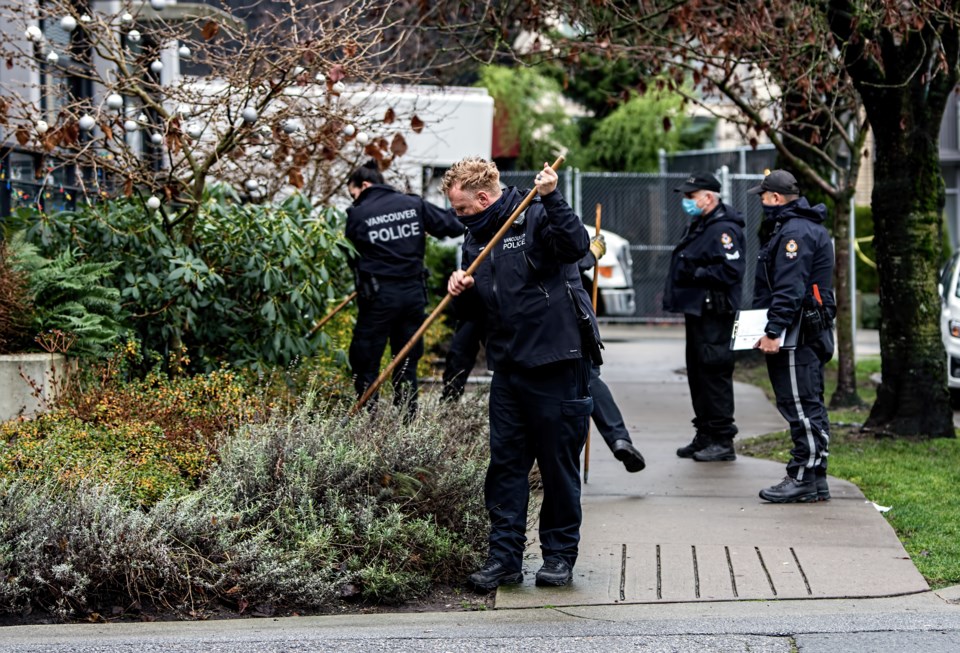But the 19 homicides — which match a recent high in 2017 — is still a low rate when compared to the 276 murders police investigated between 1990 and 1999, many of which were connected to gang violence.
Over the past six years, 91 people were murdered in Vancouver.
That includes this year’s 19 victims along with 16 in 2015, 12 in 2016, 19 in 2017, 15 in 2018 and 10 last year — their deaths a circumstance only understood by their killers, some of whom arrested, charged and convicted, while others remain at large.
Const. Tania Visintin, a Vancouver Police Department media liaison officer, wouldn’t speculate on why homicides go up or down in a given year. But she acknowledged gang activity in combination with the drug trade have been historical factors driving the violence.
At the same time, police have gained more intelligence on organized crime since the 1990s, fortified its department with a gang crime unit and supported programs such as Bar Watch and Restaurant Watch that root out gangsters.
“We have all these programs that make the police more visible,” Visintin said.
“We do our walkthroughs [in bars and restaurants] and we ask people to leave who have gang affiliations. We have that presence. It doesn’t mean it’s going to stop [a homicide] from happening, but there is more of an overt presence of the police than say there was in the 1990s.”
Although gang violence dominates headlines, victims of homicides in Vancouver this year have included people such as Jesus Cristobal-Esteban, whose friends told Glacier Media his death may have been related to an altercation over a beer.
Cristobal-Esteban, 62, was visiting Oppenheimer Park when he was beaten in the afternoon of New Year’s Day and died the next day in hospital. Glen Domenic Martin, 50, was arrested and charged with manslaughter.
The city’s most recent homicide victim, 72-year-old Alex Gortmaker, died Tuesday after being stabbed to death at the former Biltmore Hotel at Kingsway and East 12th Avenue. The hotel was transformed into transitional housing in 2014.
Visintin said a 27-year-old man was arrested in connection with what she described as an altercation between Gortmaker and a younger man. Investigators don’t believe Gortmaker and his attacker knew each other.
Gortmaker’s death came six days after 19-year-old Amar Najat Jalal died after he was found suffering from gunshot wounds around 8 p.m. on Dec. 11 in the intersection at East Fifth Avenue and Cassiar Street.
Police believe Jalal was targeted. No arrests have been made.
Jalal died one week after another 19-year-old man, Thomas Simon, was stabbed in the early evening of Dec. 4 at North Templeton Drive and Powell Street. He was taken to hospital where he died.
Police believe Simon was targeted, with preliminary evidence suggesting three people dressed in black with face masks were seen fleeing the scene. No arrests were made.
Investigators don’t believe the three homicides in December are connected.
Though the majority of homicides police investigate are targeted, Visintin cautioned residents should still be vigilant, noting 15-year-old Alfred Wong, an innocent victim, was killed in a crossfire at Broadway and Ontario Street in January 2018 while riding in a car with his parents.
10 homicides in Surrey
In Surrey, police had as of Wednesday reported 10 homicides, half of what the province’s second biggest municipality recorded in 2019. Fifteen occurred in 2018 and 12 in 2017.
Across the region and outlying areas, the Integrated Homicide Investigation Team, or IHIT, had reported 35 homicides as of Wednesday, which included the 10 in Surrey. IHIT investigated 37 murders last year.
IHIT serves 28 communities in B.C. policed by RCMP and is responsible for homicide investigations in Port Moody, New Westminster, Abbotsford and West Vancouver, where those cities’ municipal departments rely on the expertise of the unit.
Sgt. Frank Jang, a spokesperson for IHIT, echoed some of what Visintin said about motives for homicides largely connected to gangs and the drug trade and committed by people known to the police.
“But sprinkled in between those types of files, you do see the domestic-related homicides, which is very sad,” Jang told Glacier Media. “Often, it’s the male perpetrator against the female victim. And we’ve seen parent-child homicides, which is also quite sad.”
Although a motive was never disclosed at trial, Jang noted the killing of Belgian tourist Amelie Sakkalis in the summer of 2018 as an example of other homicides investigated by IHIT.
Sakkalis was stabbed more than 40 times after hitching a ride with Sean McKenzie near Boston Bar in the summer of 2018. McKenzie was sentenced to life in prison.
Jang said IHIT’s solve rate has hovered around 60 per cent, noting the work of specialized law enforcement units, including the Combined Forces Special Enforcement Unit, has also likely prevented homicides.
“When they put away people for weapons offences, drug offences, that does impact the violence that we don’t see,” he said.
In Edmonton, police had as of Tuesday reported 35 homicides this year and 26 in 2019.
Calgary’s five-year average for homicides has been 19.2 with 25 recorded in the first nine months of this year, according to Calgary Police Service’s third-quarter statistical report.
Statistics Canada’s most recent data on homicides showed police reported 678 homicides last year across the country, 20 more than the previous year. The increase in the national number of homicides was driven by Saskatchewan (21 more than 2018), Alberta (19 more) and Manitoba (17 more).
@Howellings



